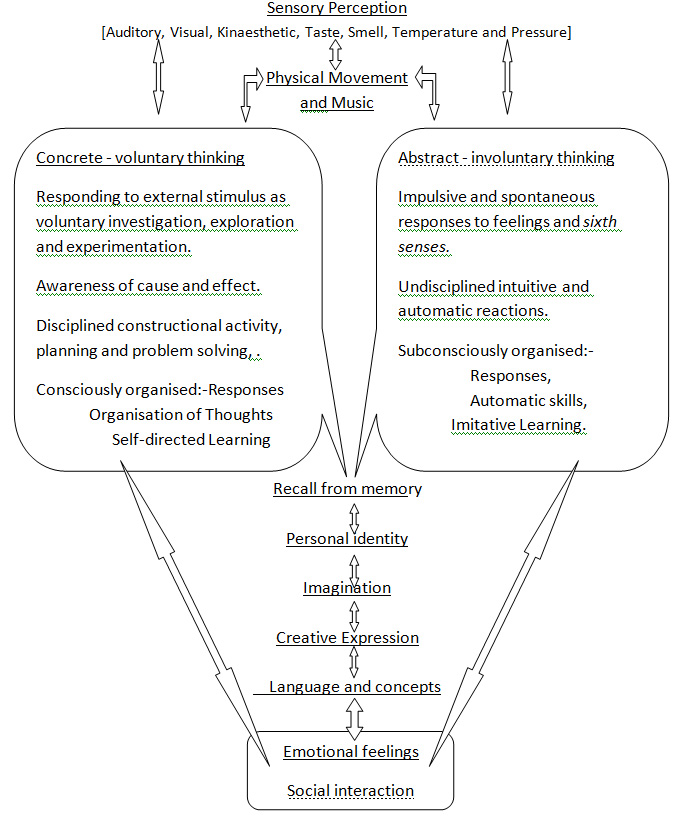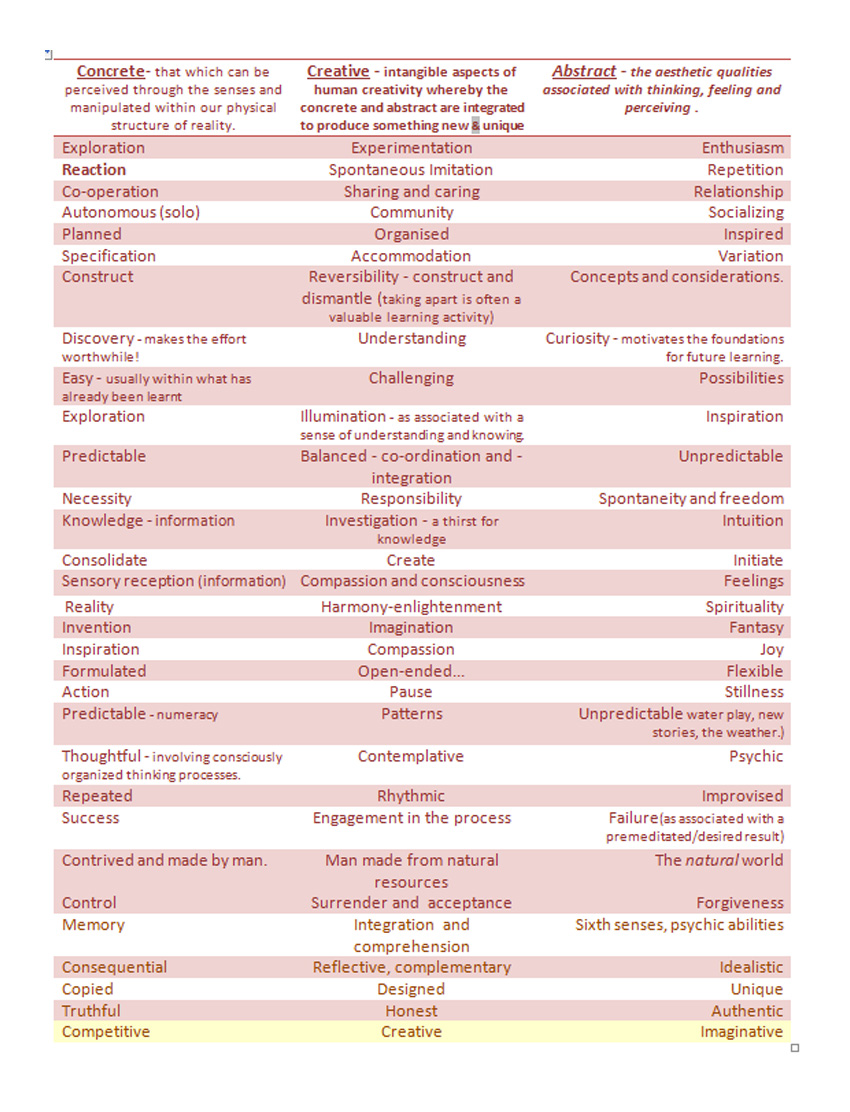Montessori presents that the language skills acquired during this sensitive period for language are significantly important for all further language development. When illustrating the use of a specific piece of sensorial apparatus Montessori recommends adults facilitate Edouard Seguin’s ‘Three Period Lesson’ presented as follows:-
1st Period: The vocabulary that is specifically represented by or associated with the apparatus.
2nd Period: The child is asked to use the apparatus to indicate the meaning of the vocabulary that the apparatus illustrates.
3rd Period: The child is asked to provide the language that describes the information presented within the sensorial apparatus. (LMC,1982:43)
The London Montessori Centre quotes that Montessori advised that the “three period lesson” of Seguin should be usedto present the relevant vocabulary and language in conjunction with any specific piece of sensorial apparatus.
Thus in the first period the child hears the new language and vocabulary which is provided in association with a concrete learning experience. In the second period the new vocabulary is presented to the child who then uses the concrete materials to indicate their understanding of the new vocabulary. In the third period the child is asked questions about the apparatus so that he can illustrate that he has internalised a working knowledge of the new vocabulary and can use it appropriately. (L.M.C.: 1982:43)
Steiner organically incorporates this three part presentation as three consecutive lessons;one each day over a three day period.
1st Lesson: The first lesson-involves a multisensory presentation of information.
2nd Lesson: The second lesson involves the opportunity to explore and personalise awareness through experiential experience.
3rd Lesson: The third lesson provides opportunities for integration with previous learning and creative expression.
A presentation of normal stages of learning is described below in relation to Environmental stimulus
Helena presents that learning is indeed achieved during a series of opportunities that present three or more opportunity for play and learning through exposure to the same environmental situation. Each period of learning opportunity should ideally offer freedom to engage in self-directed play along with an opportunity to engage in social interaction; whereby the participant is given suitable opportunity to engage in self-directed learning through exploration, experimentation and enthusiasm for creative endeavour.
Helena describes these consecutive four levels of experience as shown in a) to d):-
- Sensory stimulus-explicit and detailed sensory exploration of the present environment. Assimilation of sensory information presented by the environment.Thus a sense of sensory awarenessis gainedthrough physical sensory perceptual assessment of the environment. This process involves the creation of an inner map of the immediate environmentgained through sight, hearing, touch, smell, taste and physical movement.
- Concrete integrationof sensory-perceptual information – physical multi-sensory enrichment. Experiential experiences, constructional sensory-motor activity and interactive experimentation.Active use of memory skills.
- Abstract –thinking/feeling– Aesthetic appreciation consolidation of conceptual understanding; feelings – energy, moods, disposition, attitude, witnessing ones desires and recalling aspects of the previous two days.
As a consequence of a meaningful integration of the above first three stages of experience we can develop deeper levels of understanding and use the initial a), b)and c) foundations to initiate foundations for creative endeavour and new learning. This additional level of living and learning is based upon our own unique capacity to engage in:-
- Creativity-imaginative integration of a, b, and c (sensory, concrete, and abstract) with authentic and unique aspects of personal individuality. These are the heart and soul connections that nurture dreams, morals and beliefs, and initiate Spiritual experiences of reverence, compassion and gratitude.
The following is a brief example of the above theory in practise on a natural beach environment:-
| Day One(a) Mobility – sensory exploration, assessment of environment, establishing boundaries, and knowledge of the environmental geography | Day Two (b) Increasing sensory experiences.Gross motor interaction – initiating physical effort.
A strong sense of action and reaction. E.g. running away from the waves; splashing, diving, sitting in the shallow waves; throwing sand, digging a hole, covering yourself or someone else burying them in the sand; playing chase games on the sand, or in the water, stamping on shells and worm castings, collecting seaweed or driftwood for a fire, collecting other items from shore line old rope containers etc. Exploring environmental and social aspects of control – testing boundaries: Sensory experiences upgraded to a maximumExcitement and enthusiasm, over enthusiastic attention seeking /challenging behaviour, seeking |
| Day Three (c) Creative activity.Physical games: e.g. surfing the waves with or without learning to swim, playing catch on the beach and/or in the sea.
Building and Designing: sand structures, models, patterns and drawings. Making a model sand village, decorating sand structures, sandcastles, waterways and three dimensional structures. Constructing: a sun-shade, tent or wind-break from driftwood, sticks and stones. |
|
| Day Four (d) Relaxation, a heart-felt accommodation of previous experiences, recapping and remembering , recall and meditation. Spiritual experiences of reverence, compassion, gratitude and appreciation. | |
| When imagination is sympathetic to compassion, wisdom can manifest as a natural remedy to the challenges of life and creative expression can flow into our everyday life. |
Much of children’s play activity today is occupational rather than educational. Their activities are focussed on or dominated by the reception of new sensory stimulus described above in (1). As a direct response to a life style flooded with new and often overwhelming stimulus a child may seek physical activity that is either minimal or directly related to active repetition that prolongs a specific sensory experience and creates a predictable and familiar sensory experience. Our daily activities are often so highly stimulating that much of a child’s day can be occupied by acclimatisation i.e. getting familiar with the ever changing concoction of sensory stimulation.
Children thereby gain a large amount of sensory input but little opportunity to actively explore the context and interrelated nature of their ever-stimulating variety of different sensory experience. Because children by nature need to be physically active they establish a repertoire of occupational responses, which provide opportunity to move within the context of prolonged and strong sensory stimulation. For example the young child watching TV may suck a blanket or manipulate a cuddly toy, older children play on computer games that require fast repetitive button pushing movements. The author describes these predominantly receptive sensory occupations as entertainment. Entertainment here describes situations that hold a child’s focus in the first level of learning: sensory stimulus as above in (1)
Media Entertainment
Media entertainment is generally a passive experience founded upon receiving sensory stimulus. It eliminates the vibrancy associated with multi-sensory integration and interactive discovery learning. Media entertainment has a particular sensory focus that excludes multisensory interaction, and spontaneous social interaction.
For example watching a DVD presents a specific aspect of fixed visual dominance from the screen similarly listening to recorded music presents an auditory dominance. The lack of exploratory interaction limits our understanding of media entertainment to our previous personal interactions and learning. In contrast to these media activities, watching a live theatrical performance or live musical production incorporates a wide spectrum of new sensory perceptual experience as well as a sense of social interaction. A similar decrease in sensory interaction is also present when we consider the difference between reading a book for ourselves or having a book read to us out aloud or hearing someone tell us a story.
Media entertainment and manufactured toys present predetermined interaction along with a specified and often inflexible range of sensory experience. They direct structured responses and aspects of learning are largely predetermined by specified interaction and predictable sensory experiences.
Steiner schools today present that watching television does not meet our sensorial needs for living and learning. Furthermore watching TV and computer screens prevents children from receiving what they need for appropriate physiological and sensory development.
Steiner emphasised the need to learn through movement and multi-sensory experience. Watching TV and computer screens does not involve any body movement and presents an unnatural dominance of visual stimulus, much of which may be outside of a child’s own personal experience and meaningful reality. D. Sloan describes his concerns as follows:- …..
‘- through television, movies, literalistic picture books, detailed toys that leave nothing to the child’s own imaginative powers – children are made increasingly vulnerable to having their minds and feelings filled with ready-made, supplied images – other people’s images…..’ (Steiner, 1988:Forward)
Even todays interactive computer games require simple repetitive movements that exclude any personal levels of creative interaction. We need to consider how the modern explosion of media entertainment may have dulled our multisensory awareness and channelled our responses away from any interactive exploration and creative expression.
Similarly, when we receive stimulus levels that are beyond our ability to consciously organise from a positive perspective of understanding, can we successfully regulate our behaviour and perception of choice? Can we apply our conscious will to living and learning through the reception and integration of the sensory information? When media entertainment distracts us from association with each other and our natural surroundings, what possibility is there for intellectual and personal development?
Another important aspect of self-directed learning is sometimes described as the element of surprise. A sudden awareness of something beyond preconceived elements of interaction into previously undefined areas of potential. This aspect of learning is generally present within discovery learning and naturally offers scaffolding for self-correction.
| …..Yet wisdom is justified (proved right) by her deeds….[Matthew 11:19] |
Occupational Versus Educational Activity
Occupational activity is notably supported by an externally specified repertoire of stimulus-response activities that support either active repetitive responses or passive primitive (automated) reactions.
Examples of entertainment:-
- Television
- Back ground TV, music or radio programmes
- Repetitively reactive man-made toys and uniform building blocks which minimises the creative potential due to structural formality and pictures of predetermined designs.
- Food stimulants found in junk food (artificial colourings flavourings and preservatives, sugary sweets, chocolate, coffee and peppermint, alcohol.
- Over stimulating new and exciting environments that create abnormally high adrenalin levels for abnormally long periods and/or disrupts normal healthy sleep patterns.
- Dominating adult speeds of activity and adult schedules.
- Libertarianism, I can do anything I want, and you can do anything you
- Rigid routines, mechanical or theatrical styles of response that exclude authenticity.
- When the adult replaces a ‘don’t know’ response with a ‘yes’, or the ‘I am sorry I can’t let you do that’ response with ‘it’s OK I’ll pretend it isn’t happening.’
- When verbal communication is overwhelming the child’s free expression and movements and/or physical punishment is so intense it dominates over the child’s self-directed play responses.
- Adult initiated/motivated/enforced apprenticeship into clubs and classes, e.g. ballet or boxing. [Only when attendance is genuinely child motivated and appropriate to the child’s ability, personality, age and development, will the child develop the genuine engagement, empathy and interest related to meaningful learning.]
- Adult entertainment: adult social events, cinema, theatre, dining out etc.
‘Objectives are clear, priorities are in place’ but we still have ‘to get from the abstract to the concrete. We must move from the “if” to the “then”. [What is Peace by Stuart Briscoe Life 2010,page 71.www.telling the truth.org.uk ]
This may initially require a level of abstract conviction and concrete commitment; whereby, abstract and concrete agree to cooperate as colleagues rather than compete as rivals.
Abstract & Concrete Thinking
The following diagram has been designed by the author to illustrate her own understanding of associated areas of abstract and concrete development. It is important that everyone, and especially children,is encouraged to integrate functions in the brain in a balanced way that promotes more complex areas of learning and appropriate interactive responses.


